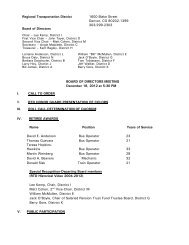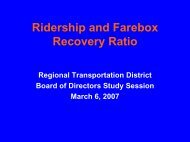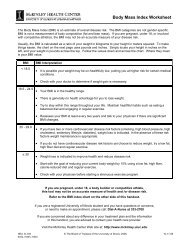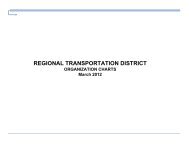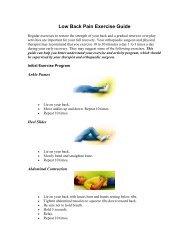Commuter Rail AC Electrification Load-Flow Simulation Report - RTD
Commuter Rail AC Electrification Load-Flow Simulation Report - RTD
Commuter Rail AC Electrification Load-Flow Simulation Report - RTD
You also want an ePaper? Increase the reach of your titles
YUMPU automatically turns print PDFs into web optimized ePapers that Google loves.
<strong>Commuter</strong> <strong>Rail</strong> <strong>AC</strong> <strong>Electrification</strong> <strong>Load</strong>-<strong>Flow</strong> <strong>Simulation</strong> <strong>Report</strong> Revision 1<br />
5.0 STUDY CRITERIA<br />
5.1 SYSTEM VOLTAGES<br />
5.1.1 Industry Practice<br />
The suitability of the selected traction power substation, switching station, and autotransformer<br />
locations is verified by determining the train voltage drop profile along the system. In a traction<br />
power system, comprising of the utility network, substation equipment, feeders, catenary<br />
conductors, and rails, every train on the system should have adequate voltage at the<br />
pantograph for propulsion purposes. The adequate voltage levels are defined by the American<br />
<strong>Rail</strong>way Engineering and Maintenance-of-Way Association 5 (AREMA) recommendations.<br />
The AREMA Manual for <strong>Rail</strong>way Engineering defines the following standard voltages:<br />
• Nominal Operating Voltage. Voltage measured at the pantograph of a train located at<br />
the substation feed point while full rated power is being drawn from the appropriate<br />
substation transformer or transformers if connected in parallel, 25 kV for the <strong>RTD</strong><br />
system.<br />
• Normal Upper Voltage Limit. Voltage measured at the pantograph of a train located at<br />
the substation feed point with no traction power being drawn from the appropriate<br />
substation transformer or transformers, if connected in parallel. The Normal Upper<br />
Voltage Limit is 110% of the Nominal Operating Voltage, 27.5 kV for the <strong>RTD</strong> system.<br />
• Normal Lower Voltage Limit. Voltage measured at the pantograph of a train located at<br />
the point of maximum voltage drop with the OCS functioning for normal design<br />
conditions, assuming no substation outage and rated continuous power being developed<br />
by the rolling stock. The Normal Lower Voltage Limit is 80% of the Nominal Operating<br />
Voltage, 20 kV for the <strong>RTD</strong> system.<br />
• Emergency Minimum Operating Voltage. Voltage measured at the pantograph of a train<br />
operating under emergency conditions, such as a substation outage, loss of one or more<br />
transformers at a substation, or utility supply problems. Rated vehicle power and<br />
performance is not available, but reduced operation is possible, assuming that on-board<br />
logic automatically degrades the vehicle performance. The Emergency Minimum<br />
Operating Voltage Limit is 70% of the Nominal Operating Voltage, 17.5 kV for the <strong>RTD</strong><br />
system. As per the American <strong>Rail</strong>way Engineering and Maintenance-of-Way<br />
Association recommendations, this limit applies to vehicle design only and is not to be<br />
used as a criterion for the traction power system design.<br />
5.1.2 <strong>RTD</strong> System Voltages<br />
Taking into account the AREMA recommendations, the traction power supply and distribution<br />
system voltage levels for the <strong>RTD</strong> 2x25 kV autotransformer-fed system, as developed for this<br />
study, are shown in Table 2.<br />
5 AREMA, Manual for <strong>Rail</strong>way Engineering, Chapter 33, Electrical Energy Utilization, Part 3,<br />
Recommended Voltages, published in 2006.<br />
02/27/2009 FRSC Page 16 of 250




